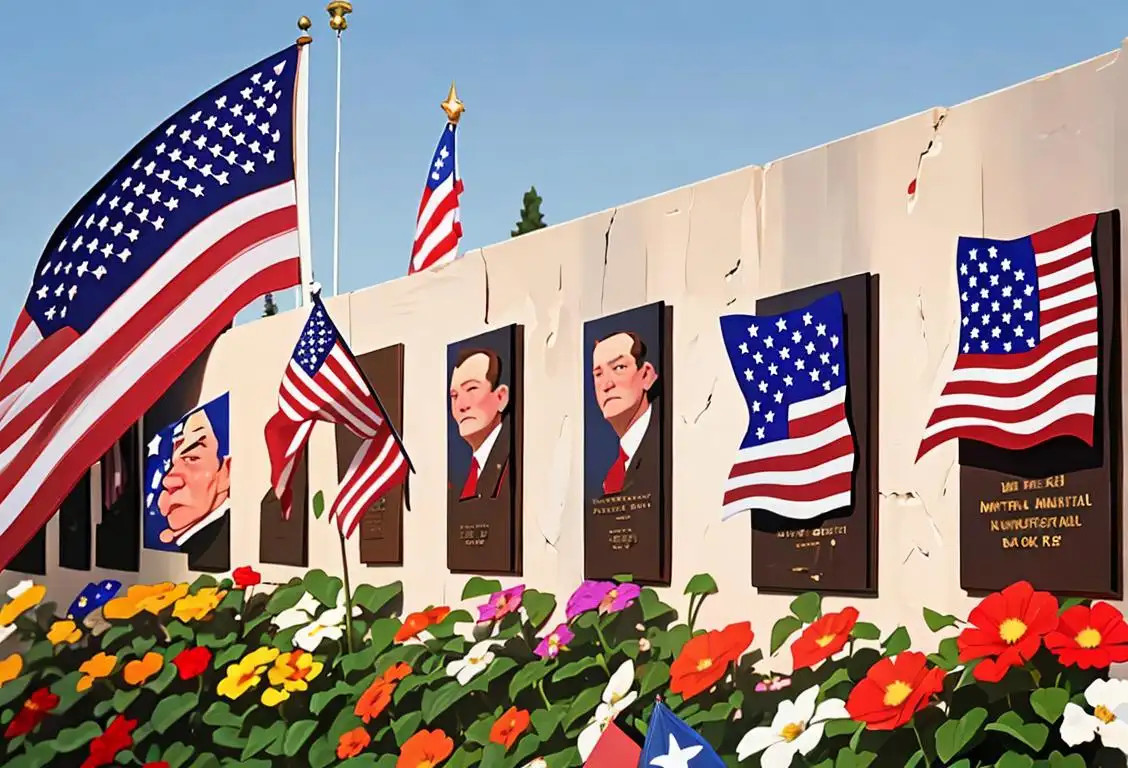National Traffic Safety Day

Welcome to WhatNationalDayIsIt.com, where we uncover the fascinating history behind all those quirky national days! Today, buckle up and adjust your rearview mirror because it's National Traffic Safety Day!
When is Traffic Safety Day?
It's national traffic safety day on the 29th November.
The Importance of National Traffic Safety Day
On this special day, we come together to raise awareness about the importance of road safety. And trust me, it's no joke – traffic can be downright crazy out there! From distracted drivers to impatient honkers, the roads can sometimes feel like a battleground. But fear not, fellow travelers, for National Traffic Safety Day is here to the rescue!
This annual occasion serves as a reminder for all of us to be extra cautious and responsible behind the wheel. It's a day to focus on promoting safe driving practices, educating ourselves about road rules, and ensuring the well-being of all road users.
Let's Stay Safe out There!
Now, you might be wondering, how can I make the most of this day? Well, fear not! We've got some top-notch safety tips lined up for you:
- Buckle up for safety: Always wear your seatbelt, even if you're just going on a short drive to grab some ice cream. Safety first, my friend!
- Put the phone away: Texting, Instagram scrolling, or watching cute puppy videos on your phone while driving is a big no-no! Keep your hands on the wheel and your focus on the road.
- Mind the speed limit: Life's not a race, unless you're on a racetrack. Stick to the posted speed limits and avoid any unpleasant run-ins with traffic cops.
- Don't drive under the influence: Feeling a little tipsy after that outdoor picnic? Don't even think about getting behind the wheel! Call a friend, book a rideshare, or take a leisurely walk instead. Safety and sobriety go hand in hand.
- Be a good neighbor: Use your turn signals, let pedestrians cross safely, and practice courteous driving. Remember, we're all in this traffic jam together.
Spread the Word and Strap In!
So, my friends, on this National Traffic Safety Day, let's make a pledge to be responsible drivers, share the road with respect, and ensure the safety of our loved ones and fellow travelers. Together, we can transform the roads into a much safer place!
History behind the term 'Traffic Safety'
1903
Emergence of Motor Vehicles
As motor vehicles became increasingly popular in the early 20th century, it quickly became apparent that regulations were necessary to ensure public safety. The rising number of accidents and fatalities prompted the need for traffic safety measures.
1920
The Birth of Traffic Safety
In the early 1920s, as motor vehicles became more prevalent, the need for regulations and safety measures became apparent. Traffic accidents were on the rise, leading to injuries and fatalities. This prompted various organizations and government bodies to start addressing the issue of road safety.
1903
Birth of the Motor Car
In 1903, the mass production of the motor car began, revolutionizing transportation. With more cars on the road, concerns about road safety started to emerge.
1920
The Birth of Traffic Safety
The term 'traffic safety' was born in 1920 as cities began to experience an increase in motor vehicle accidents. With the rising popularity of automobiles, city streets became more congested, leading to a rise in accidents and fatalities. Recognizing the need to address this growing concern, experts and civic organizations started focusing on implementing measures to improve safety on the roads.
1923
First Traffic Light
The first electric traffic light system was installed in 1923 in Cleveland, Ohio. Its purpose was to bring order to an increasingly congested intersection. Although it had limited functionality compared to modern traffic lights, it marked a major step in regulating traffic.
1927
The First Traffic Safety Campaign
In 1927, the first official traffic safety campaign was launched by the American Automobile Association (AAA). This marked a significant step towards promoting safe driving habits and reducing the number of accidents. The campaign aimed to educate drivers on traffic rules, proper signage, and the importance of responsible driving. The efforts of the campaign generated public awareness and paved the way for future initiatives to prioritize traffic safety.
1904
Introduction of Traffic Signals
The world's first known traffic signal was installed in Cleveland, Ohio. Developed by James Hoge, the device had two colors, red and green, to control vehicular traffic. Although rudimentary by today's standards, it marked a major step towards improving traffic safety.
1927
First Traffic Safety Campaign
In 1927, the American Automobile Association (AAA) initiated the first national traffic safety campaign in the United States. The campaign aimed to raise public awareness about the importance of obeying traffic laws, using traffic signals, and driving responsibly. This marked a crucial milestone in promoting a culture of traffic safety.
1935
The Introduction of Driver Education
In 1935, driver education became a pivotal component of traffic safety initiatives. Schools started offering driver education courses to teach young individuals about the rules of the road and proper driving techniques. These programs aimed to instill the importance of safe driving practices early on and reduce the number of accidents caused by inexperienced drivers. The inclusion of driver education within school curriculums played a crucial role in nurturing a responsible driving culture.
1935
Establishment of the National Highway Traffic Safety Administration
In 1935, the National Highway Traffic Safety Administration (NHTSA) was established in the United States. This federal agency was given the responsibility of setting and enforcing vehicle performance standards and regulations, promoting education and research on traffic safety, and collecting data to support evidence-based policies. The establishment of NHTSA played a key role in shaping the modern discipline of traffic safety.
1935
Invention of the Stop Sign
In 1935, the stop sign as we know it today—red octagon with white lettering—was standardized in the United States. The stop sign played a crucial role in improving traffic safety by requiring drivers to come to a full stop at intersections.
1920
Establishment of Traffic Police
To enforce traffic rules and maintain order on the roads, various cities around the world began employing dedicated traffic police officers. These officers were tasked with ensuring the safe movement of vehicles and pedestrians, helping reduce accidents and congestion.
1950
The Rise of Traffic Engineering
By the 1950s, traffic engineering emerged as a formal discipline to address the challenges of increasing traffic congestion and safety concerns. Traffic engineers focused on designing roadways, intersections, and traffic control systems to enhance safety for all road users. This marked a significant shift from solely educating drivers to incorporating infrastructure improvements as part of comprehensive traffic safety strategies.
1935
First Driver's Education Program
In response to the rising number of road accidents, Kansas became the first state to introduce a formal driver's education program in schools. This important step aimed to educate young drivers about the rules of the road and promote safer driving habits.
1938
First Driver's Education Programs
Recognizing the need for formal driver training, the first driver's education programs were introduced in the late 1930s. These programs aimed to educate drivers about the rules of the road and promote safe driving practices.
1965
Introduction of Seat Belt Laws
In 1965, the state of Wisconsin in the United States became the first to enact a mandatory seat belt law. This step was taken to encourage the use of seat belts and reduce injuries in case of accidents. Over time, many other states and countries followed suit, recognizing the importance of seat belts in saving lives and preventing severe injuries.
1956
Invention of Seat Belts
Volvo engineer Nils Bohlin introduced the three-point seat belt, a revolutionary design that greatly enhanced vehicle safety. The seat belt quickly became a standard feature in most cars and played a crucial role in reducing injuries and fatalities in traffic accidents.
1947
National Traffic Safety Movement
In 1947, the National Traffic Safety Movement was established in the United States, focusing on reducing traffic accidents and promoting safety awareness. This movement paved the way for the development of comprehensive traffic safety strategies.
1965
National Traffic and Motor Vehicle Safety Act
In 1965, the United States passed the National Traffic and Motor Vehicle Safety Act as a response to the alarming number of traffic-related injuries and fatalities. This legislation established federal safety standards for motor vehicles and authorized the creation of the National Highway Traffic Safety Administration (NHTSA). The NHTSA took on the responsibility of researching and implementing safety measures, conducting crash tests, and advocating for vehicle safety improvements. This act marked a significant milestone in the prioritization of traffic safety on a national scale.
1970
Formation of the World Health Organization (WHO) Road Safety Programme
In 1970, the World Health Organization (WHO) established its Road Safety Programme, focusing on global efforts to prevent road traffic crashes and reduce the associated injuries and fatalities. The program provides guidance, research, and technical support to countries to develop and implement effective road safety strategies. It serves as a platform for international collaboration and knowledge-sharing in the field of traffic safety.
1965
Creation of National Highway Traffic Safety Administration
The National Highway Traffic Safety Administration (NHTSA) was founded in 1965 as a direct response to increasing concerns about traffic safety. The NHTSA's mission is to save lives, prevent injuries, and reduce road traffic crashes through research, education, and enforcement.
1997
Global Road Safety Partnership
In 1997, the Global Road Safety Partnership (GRSP) was formed, bringing together various stakeholders, including governments, international organizations, NGOs, and private sector companies. GRSP works towards improving road safety by facilitating collaboration, sharing best practices, and advocating for evidence-based policies. The partnership plays a crucial role in coordinating global efforts to reduce traffic-related injuries and deaths.
2000
Advancements in Vehicle Technology and Safety
With advancements in technology, the early 2000s witnessed a significant focus on incorporating safety features into vehicles. Innovations such as electronic stability control, advanced driver assistance systems, and crash-avoidance technologies revolutionized the automotive industry's approach to traffic safety. These advancements aimed to mitigate human error and reduce the likelihood of accidents. The integration of technology played a crucial role in further enhancing the safety of drivers and passengers.
1965
Formation of National Highway Traffic Safety Administration
In response to the increasing importance of traffic safety, the United States established the National Highway Traffic Safety Administration (NHTSA). The NHTSA is responsible for setting and enforcing vehicle performance standards and promoting road safety initiatives across the country.
Present
Continued Efforts and Awareness
In the present day, traffic safety remains a paramount concern globally. Efforts to improve traffic safety continue through various strategies, including public awareness campaigns, law enforcement, improved infrastructure, and ongoing research and development of safety technologies. The term 'traffic safety' represents the collective efforts undertaken over the years to foster safer roads and protect the lives of all road users.
1970
First National Traffic Safety Awareness Campaign
In 1970, the United States launched its first national traffic safety awareness campaign called 'Operation Awareness.' This campaign aimed to educate the public about safe driving practices and promote responsible behavior on the road.
1970
Introduction of Drink Driving Laws
Recognizing the dangers of drunk driving, countries worldwide began introducing drink driving laws. These laws imposed penalties for driving under the influence of alcohol or drugs, significantly reducing the number of alcohol-related accidents and saving countless lives.
1990
Advancement of Vehicle Safety Technology
The 1990s saw significant advancements in vehicle safety technology. Features such as anti-lock braking systems (ABS), airbags, and electronic stability control (ESC) became standard in many vehicles, providing additional layers of protection for drivers and passengers.
2000
Focus on Pedestrian Safety
With an increasing emphasis on pedestrian safety, cities worldwide began implementing measures to protect pedestrians. This included the introduction of crosswalks, traffic calming measures, and improved street designs to reduce accidents involving pedestrians.
2020
Rise of Autonomous Vehicles
The development of autonomous vehicles has the potential to revolutionize traffic safety. Through advanced sensors, machine learning, and artificial intelligence, these vehicles aim to eliminate human error and greatly reduce the number of accidents on the road.
Did you know?
Did you know that traffic jams were once called "horseless carriage jams" because they were originally caused by horse-drawn vehicles? Thank goodness for the invention of cars and traffic safety measures!Tagged
awareness loved onesFirst identified
3rd December 2016Most mentioned on
29th November 2020Total mentions
28Other days
Compliment Day
Cheese Pizza Day
Pumpkin Day
Medal Of Honor Day
Guac Day
Foundation Day
Suicide Prevention Day
Memorial Day
Cancer Survivors Day
Bacon Day









